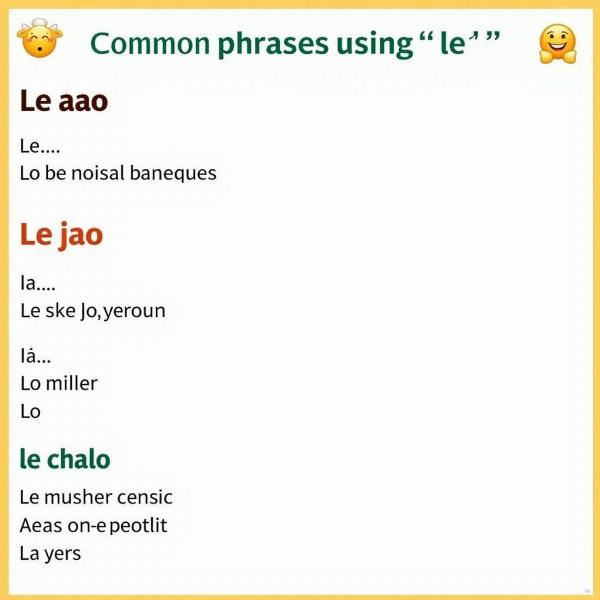Understanding the nuances of “le” in Hindi can be tricky, especially for non-native speakers. This seemingly small word carries significant weight in conversations, influencing the tone and meaning of sentences. This guide will delve into the various meanings and uses of “le,” providing examples and context to help you master its application.
Decoding the Multifaceted “Le”
“Le” in Hindi doesn’t have a single, direct English translation. Its meaning depends heavily on the context and the intonation used. It can express a range of emotions, from encouragement and persuasion to mild annoyance and dismissal. Let’s explore some of its common interpretations.
“Le” as a Marker of Taking or Receiving
One of the most common uses of “le” is to indicate the action of taking or receiving something. Think of it as the equivalent of “take” or “here” in English. For instance:
- “Yeh lo paise.” (Here, take the money.)
- “Chai le lo.” (Take some tea.)
In these examples, “le” signifies the act of receiving the money or tea.
“Le” Expressing Encouragement or Persuasion
“Le” can also be used to encourage or persuade someone to do something. It carries a gentle nudge, often suggesting a benefit for the person being persuaded.
- “Chalo, film dekhne chalte hain, le.” (Come on, let’s go watch a movie.)
- “Ek aur samosa le lo.” (Have another samosa.)
Here, “le” adds a persuasive tone, making the suggestion more appealing.
“Le” Indicating Mild Annoyance or Dismissal
Sometimes, “le” can express mild annoyance or dismissal, especially when used with a specific tone of voice. It can signal impatience or a desire to end a conversation.
- “Achcha, le ab jaa.” (Alright, now go.)
- “Bas kar, le.” (Enough, stop it.)
In these cases, “le” conveys a sense of finality or even slight irritation.
Mastering the Art of “Le”: Pronunciation and Intonation
Using “le” correctly requires paying attention to pronunciation and intonation. The subtle differences in how you say it can significantly alter the meaning. A soft, encouraging tone implies persuasion, while a sharper tone can indicate annoyance. Practicing with native speakers can help you grasp these nuances.
Common Phrases Using “Le”
Here are some commonly used phrases incorporating “le”:
- “Le aao”: Bring (something)
- “Le jao”: Take (something) away
- “Le chalo”: Take (someone) along
 Common Phrases with "Le" in Hindi
Common Phrases with "Le" in Hindi
The Cultural Context of “Le”
Understanding the cultural context surrounding “le” is crucial for effective communication. In Indian culture, offering something with “le” is considered polite and hospitable. Similarly, accepting something with a gracious “le” shows respect and appreciation.
“Le” in Different Grammatical Contexts
While often used as a standalone word, “le” can also be combined with other words and verb forms to create more complex meanings. Exploring these grammatical variations further enhances your understanding.
Conclusion: Embracing the Versatility of “Le”
“Le” is a small word with a big impact in Hindi conversations. Mastering its various meanings and nuances is essential for effective communication. By understanding its contextual usage, pronunciation, and cultural significance, you can confidently navigate the intricacies of the Hindi language and express yourself accurately. Remember to pay close attention to the tone and context to avoid any misunderstandings. Now that you have a clearer understanding of “le,” practice incorporating it into your conversations!
FAQ
- What is the literal translation of “le” in Hindi? There is no single literal translation, as its meaning changes based on context.
- Can “le” be used formally? Yes, it can be used in formal settings, particularly when offering something respectfully.
- How can I improve my pronunciation of “le”? Practicing with native speakers or listening to spoken Hindi can help.
- Is “le” used in all Hindi dialects? While common in most dialects, its usage may vary slightly.
- Can “le” be offensive? It can convey mild annoyance depending on the tone, but it’s generally not considered highly offensive.
- What is the difference between “le” and “lo”? “Lo” is often the plural or more respectful form of “le.”
- Are there other words similar to “le” in Hindi? Yes, words like “lijiye” are more formal and respectful alternatives.
Related Articles You Might Find Useful
- i am in trouble meaning in hindi
- custard apple meaning in hindi
- dolittle meaning in hindi
- always smile meaning in hindi
About Meaning-Hindi.in
Meaning-Hindi.in is your one-stop solution for professional Hindi translation services. We specialize in a wide range of translation needs, from business and legal documents to technical manuals and website localization. Our team of expert linguists ensures accurate and culturally sensitive translations to help you bridge the communication gap. Whether you need business document translation or legal document translation, Meaning-Hindi.in provides high-quality and reliable service. Contact us today for all your Hindi translation requirements! Email: [email protected], Phone: +91 11-4502-7584.